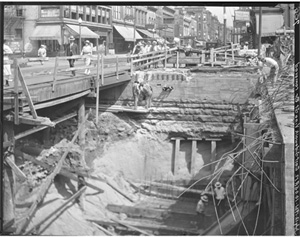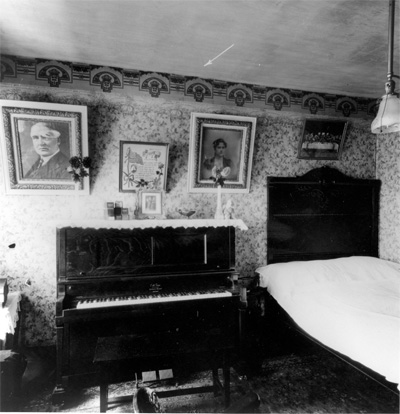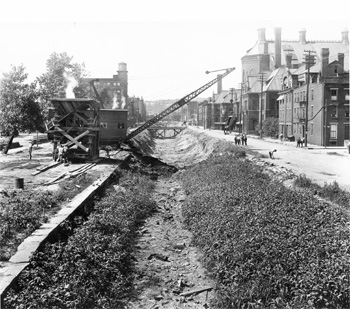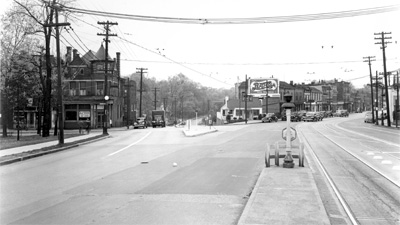 The University of Cincinnati Libraries were awarded a $60,669 Library Services and Technology Act (LSTA) grant from the State Library of Ohio to digitize and make freely available on the Web the photographic collection of Cincinnati’s subway and street changes archive.
The University of Cincinnati Libraries were awarded a $60,669 Library Services and Technology Act (LSTA) grant from the State Library of Ohio to digitize and make freely available on the Web the photographic collection of Cincinnati’s subway and street changes archive.
The approximate 8,000 negatives and prints, which date from 1920 to 1956, include both interior and exterior shots of private residences and city scenes. They were taken as part of a failed subway development project in Cincinnati and also as documentation during various street projects.
 The interior images offer an in-depth look at how a typical Ohio family lived. The products in their kitchens and the furnishings in their living rooms, with such things as player pianos and photographs on the wall, are all captured in the negatives and prints. The exterior shots show the layout of city streets and neighborhoods, stores and businesses, as well as the traffic and bustle of everyday life, not to mention the damage done by subway construction. Beyond the years of the subway project, the images of street renovations into the 1930s, ‘40s, and ‘50s eloquently illustrate the changing urban landscape.
The interior images offer an in-depth look at how a typical Ohio family lived. The products in their kitchens and the furnishings in their living rooms, with such things as player pianos and photographs on the wall, are all captured in the negatives and prints. The exterior shots show the layout of city streets and neighborhoods, stores and businesses, as well as the traffic and bustle of everyday life, not to mention the damage done by subway construction. Beyond the years of the subway project, the images of street renovations into the 1930s, ‘40s, and ‘50s eloquently illustrate the changing urban landscape.
“In this collection of historically significant materials, we have the opportunity to see how one Ohio city functioned in the first half of the 20th century,” said Kevin Grace, project co-director, university archivist, and head of the Archives and Rare Books Library where the collection resides. “Ohio residents, city planners, researchers, and scholars worldwide engaged in research in social, political, urban, and transportation history, as well as genealogical and family history research, will find much value in this collection.”
 The photographic negatives and prints are part of the Archives and Rare Books Library’s Ohio Network Collection in the state’s Local Government Records Program, a diverse body of materials that document official government activity from the 18th to the 21st centuries. The Cincinnati subway and street changes archive, which also includes construction reports, householders’ damage claims, blueprints, minutes, and correspondence, in addition to the negatives and prints, is used by researchers and students studying urban planning and development, the history of Cincinnati, American history, civil engineering, and political science. Faculty and independent scholars avail themselves of the collection for in-depth research on neighborhood decline and revitalization, America’s transportation heritage, and urban political reform movements. Additionally, in the past three years, journalists, City of Cincinnati planning officials, and neighborhood activists have consulted the documents in order to provide input for street and housing renovations and for reviving interest in downtown Cincinnati tourism.
The photographic negatives and prints are part of the Archives and Rare Books Library’s Ohio Network Collection in the state’s Local Government Records Program, a diverse body of materials that document official government activity from the 18th to the 21st centuries. The Cincinnati subway and street changes archive, which also includes construction reports, householders’ damage claims, blueprints, minutes, and correspondence, in addition to the negatives and prints, is used by researchers and students studying urban planning and development, the history of Cincinnati, American history, civil engineering, and political science. Faculty and independent scholars avail themselves of the collection for in-depth research on neighborhood decline and revitalization, America’s transportation heritage, and urban political reform movements. Additionally, in the past three years, journalists, City of Cincinnati planning officials, and neighborhood activists have consulted the documents in order to provide input for street and housing renovations and for reviving interest in downtown Cincinnati tourism.
The project to digitize the negatives and prints is slated for completion in October 2013 at which time the collection will be fully available for research and study on the Web. “This collection will be a significant addition to collections of Cincinnati historical documents already digitized by UC Libraries and available to anyone anywhere via the digital collections website at http://digitalprojects.libraries.uc.edu/,” added Linda Newman, project co-director and head of UC Libraries’ digital collections.
 “By making it a priority to digitize our unique collections such as the negatives and prints from the Cincinnati and subway street changes archive, we not only broaden the availability of such materials, but we also fulfill our mission to provide outstanding research collections in order to enable the University of Cincinnati to achieve its comprehensive mission of teaching, learning, research, health care, and community engagement,” said Xuemao Wang, dean and university librarian. “I want to express my appreciation to the State Library of Ohio for awarding UC Libraries this LSTA grant.”
“By making it a priority to digitize our unique collections such as the negatives and prints from the Cincinnati and subway street changes archive, we not only broaden the availability of such materials, but we also fulfill our mission to provide outstanding research collections in order to enable the University of Cincinnati to achieve its comprehensive mission of teaching, learning, research, health care, and community engagement,” said Xuemao Wang, dean and university librarian. “I want to express my appreciation to the State Library of Ohio for awarding UC Libraries this LSTA grant.”
The LSTA program is funded through the Institute of Museum and Library Services (IMLS) and administered through the State Library of Ohio.
